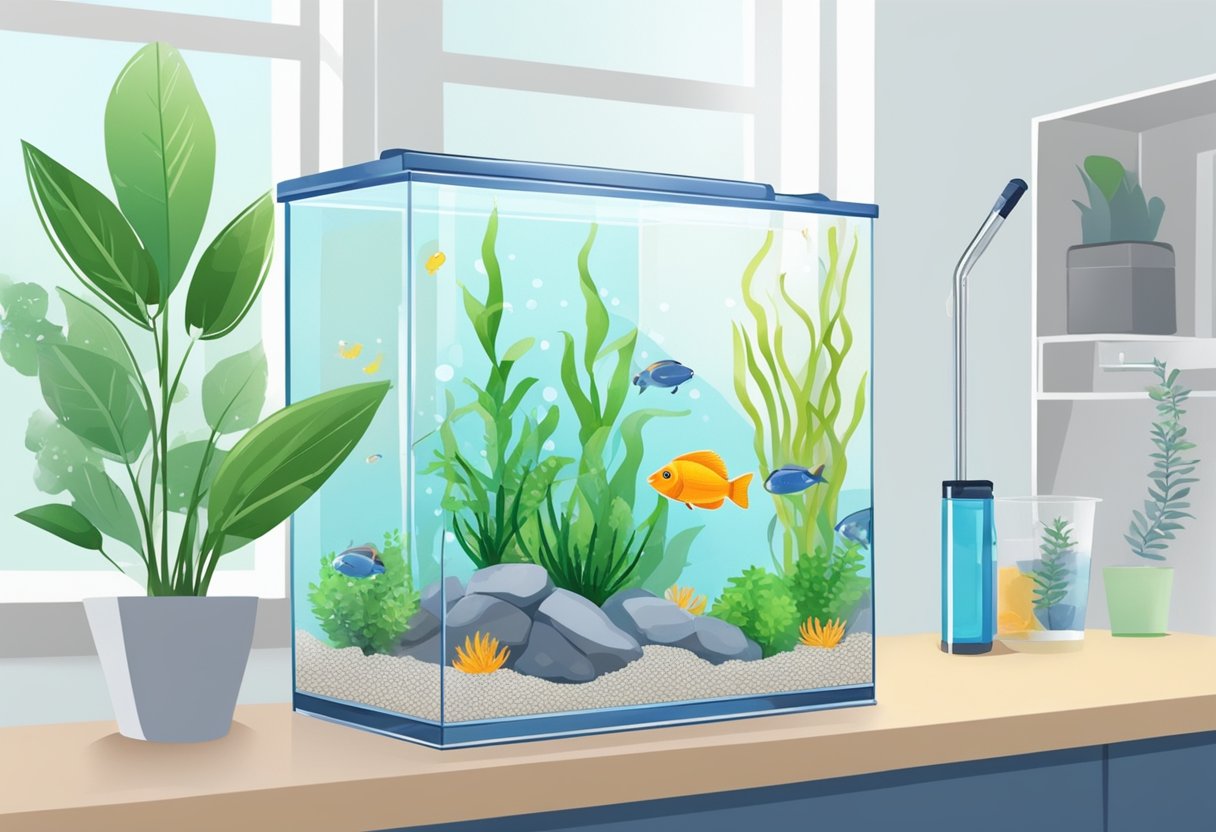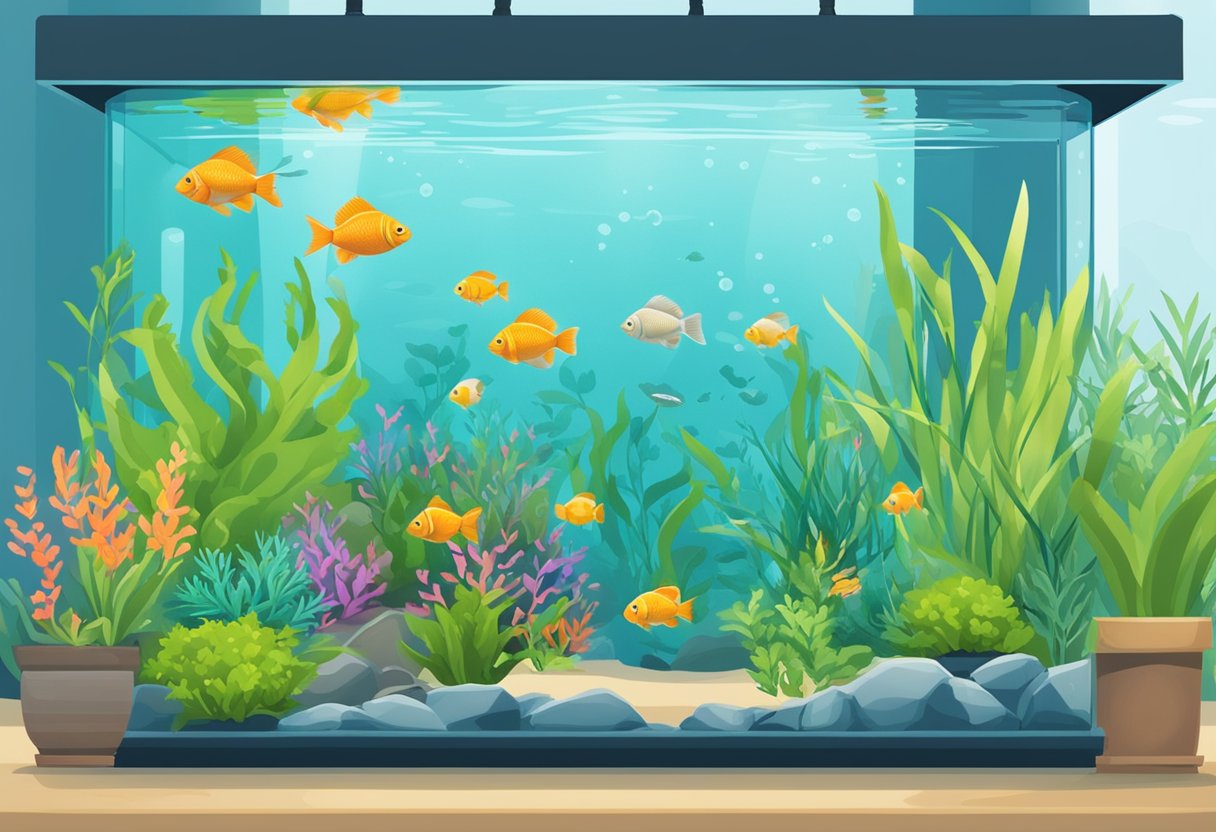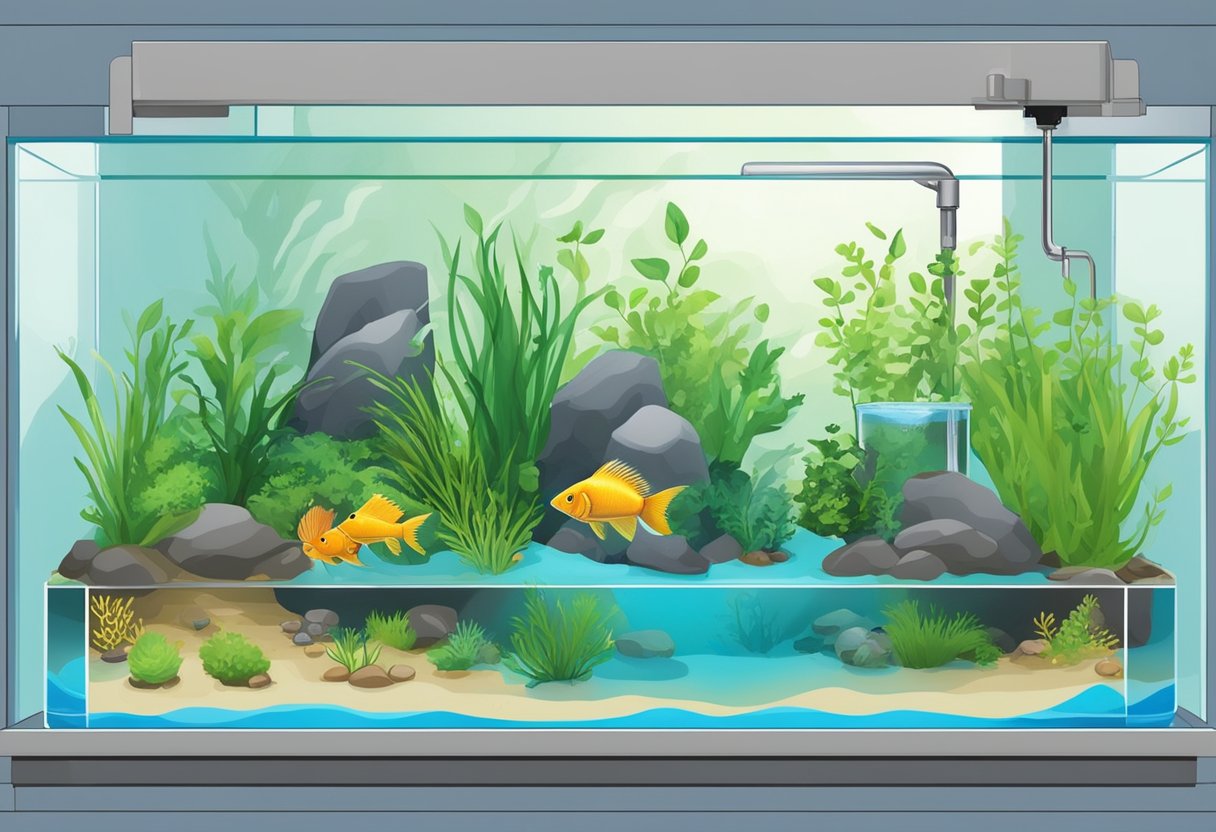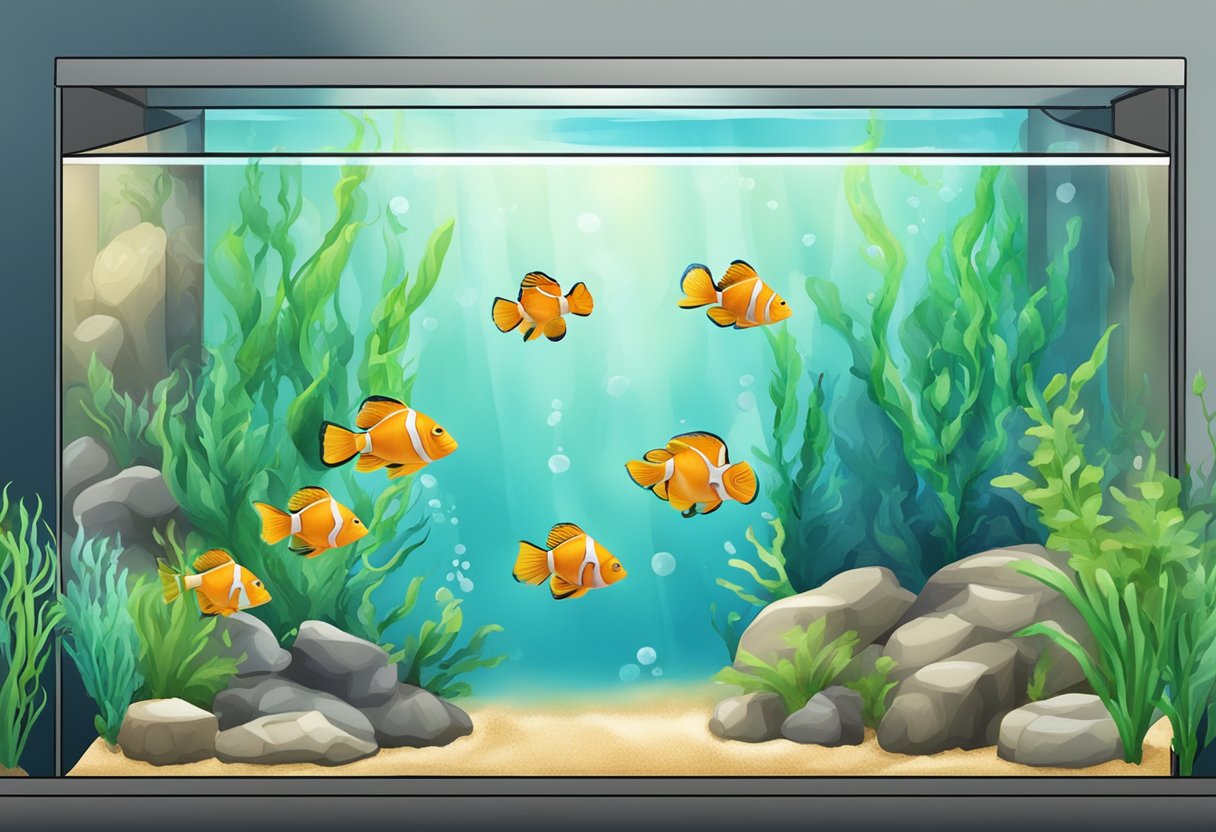Maintaining a clean and healthy fish tank requires more than just feeding your fish and changing the water occasionally. It is important to understand the basics of fish tank cleaning and maintenance to ensure that your fish stay healthy and happy. In this article, I will share some tips on how to clean and maintain your fish tank, including preparing for cleaning, cleaning the tank, and maintaining your fish tank.

Before cleaning your fish tank, it is important to understand the delicate ecosystem that exists within it. Fish tanks are home to a variety of living organisms, including fish, plants, and beneficial bacteria. Cleaning your tank incorrectly can harm these organisms and upset the delicate balance of your tank. Therefore, it is essential to prepare for cleaning by gathering the necessary supplies and learning about the nitrogen cycle, water testing, and other important factors that affect fish health.
Key Takeaways
- Understanding the basics of fish tank cleaning and maintenance is essential for keeping your fish healthy and happy.
- Proper preparation, including gathering the necessary supplies and learning about the nitrogen cycle and water testing, is crucial before cleaning your fish tank.
- Cleaning the tank and maintaining your fish tank require specific techniques and attention to detail to ensure that your fish and other organisms stay healthy.
Understanding the Basics

As a fish tank owner, it is essential to understand the basics of aquarium maintenance. Proper maintenance ensures that your fish tank remains a healthy and safe environment for your aquatic pets. In this section, I will cover the importance of cleaning, understanding the ecosystem, and recognizing the need for cleaning.
Importance of Cleaning
Cleaning your fish tank is crucial to maintaining a healthy and safe environment for your fish. Fish waste, uneaten food, and debris can accumulate in the tank, leading to the release of toxins that can harm your fish. Regular cleaning removes these toxins and ensures that the water quality remains high.
Understanding the Ecosystem
A fish tank is a delicate ecosystem that requires balance to thrive. The ecosystem consists of fish, plants, bacteria, and other microorganisms. Bacteria play a vital role in the ecosystem by breaking down fish waste and other organic matter into less harmful compounds. Plants absorb carbon dioxide and release oxygen, which is essential for fish survival. Understanding this delicate balance is crucial to maintaining a healthy and thriving fish tank.
Recognizing the Need for Cleaning
It’s essential to recognize when your fish tank needs cleaning. Signs of an unclean tank include cloudy water, algae growth, and foul odors. Regular water testing can help you determine when to perform a water change. A water change involves removing a portion of the old water and replacing it with fresh water. A siphon and bucket are useful tools for performing a water change.
Regular cleaning of the filter, gravel, and other equipment is also essential. A dirty filter can cause a buildup of harmful toxins, while dirty gravel can lead to the growth of harmful bacteria and algae. An algae scraper can be used to remove algae buildup on the sides of the tank.
In summary, understanding the basics of fish tank maintenance is crucial to maintaining a healthy and safe environment for your fish. Regular cleaning and maintenance of the filter, gravel, and other equipment, along with regular water changes, are essential to maintaining a balanced and healthy ecosystem.
Preparing for Cleaning

Before cleaning your fish tank, it is important to gather all the necessary supplies and check the water parameters. This will ensure that the cleaning process goes smoothly and that your fish are not harmed.
Gathering Supplies
To clean your fish tank, you will need the following supplies:
- Bucket
- Siphon or water siphon
- Gravel vacuum
- Algae scraper/pad
- Filter brush
- Razor blade or plastic blade
- Paper towels
- Aquarium-safe glass cleaner
- Water conditioner
- Dechlorinator
You can find these supplies at your local pet store or online. Be sure to read the labels carefully and choose materials that are safe for your fish and aquarium.
Checking Water Parameters
Before cleaning your fish tank, it is important to check the water parameters. This will help you determine if the water is safe for your fish and if any adjustments need to be made.
You will need a water testing kit to check the following parameters:
- pH
- Chlorine
- Nitrogen cycle
If any of these parameters are outside of the safe range, you will need to make adjustments before cleaning your fish tank. You can use a water conditioner or dechlorinator to remove harmful chemicals from tap water. You may also need to add ceramic rings or filter media to help maintain a healthy nitrogen cycle.
Preparation
Before starting the cleaning process, it is important to prepare your work area and yourself. Here are some tips to help you prepare:
- Wear gloves to protect your hands from chemicals and bacteria.
- Turn off all electrical equipment, including the filter and heater.
- Lower the water level to make it easier to clean the inside glass.
- Use a magnetic scrubber or algae scraper/pad to remove stubborn residue.
- Use a filter brush to clean the filter and remove any chemical residue.
- Rinse all supplies thoroughly with running water before use.
By following these steps, you can prepare for a successful fish tank cleaning session.
Cleaning the Tank
https://www.youtube.com/watch?v=8G1gQf5-xU8&embed=true
Maintaining a clean and healthy environment for your fish is crucial to their well-being. Regular cleaning of your fish tank is essential to keep your fish healthy and happy. In this section, I will discuss the steps and methods to clean your fish tank properly.
Cleaning the Interior
Cleaning the inside of your fish tank is an essential part of maintaining a healthy environment for your fish. To clean the interior of the tank, follow these steps:
- Turn off all electrical equipment.
- Remove any decorations, artificial plants, and other materials from the tank.
- Use a gravel vacuum or siphon to draw out 25-50% of the water in your tank, taking care not to disturb the substrate.
- Use a magnetic scrubber or algae scraper to clean the inside glass of the tank. Be gentle when scraping to avoid scratching the glass.
- Use a plastic blade or razor blade to remove any stubborn residue from the inside glass.
- Clean any remaining debris or algae using a sponge or cloth.
- Use an aquarium-safe glass cleaner to clean the inside glass of the tank. Avoid using any detergents or soap as they can be toxic to fish.
- Replace any decorations, artificial plants, and other materials back into the tank.
Cleaning the Exterior
Cleaning the exterior of your fish tank is also important to maintain a clean and healthy environment for your fish. To clean the exterior of the tank, follow these steps:
- Turn off all electrical equipment.
- Use a damp cloth or sponge to wipe down the outside of the tank. Avoid using any cleaning supplies that contain bleach or other harmful chemicals.
- Use an aquarium-safe glass cleaner to clean the outside of the tank. Avoid using any detergents or soap as they can be toxic to fish.
- Rinse the tank with running water.
- Dry the tank with a clean and dry cloth.
Cleaning the Filter
Cleaning the filter is an essential part of maintaining a healthy environment for your fish. To clean the filter, follow these steps:
- Turn off all electrical equipment.
- Remove the filter media and spare parts from the filter.
- Rinse the filter media and spare parts with old water from the tank. Avoid using tap water as it contains harmful toxins and nitrates.
- Use a toothbrush or sponge to clean any mechanical filter materials, such as ceramic rings or substrate.
- Reassemble the filter and replace the filter media and spare parts.
- Turn on the electrical equipment.
In conclusion, cleaning your fish tank is an essential part of maintaining a healthy environment for your fish. By following these steps and methods, you can ensure that your fish tank stays clean and healthy for your fish to thrive.
Maintaining Your Fish Tank
https://www.youtube.com/watch?v=BV4QG06OhSI&embed=true
As a fish tank owner, it’s important to keep your aquarium clean and healthy for your aquatic pets. Here are some tips on how to maintain your fish tank:
Regular Water Changes
One of the most important things you can do to maintain your fish tank is to perform regular water changes. Aim to change 25% of the water every 2-4 weeks, or 10-15% of the water every week. This will help remove any excess waste, uneaten food, or other debris that can accumulate in the tank and negatively impact the water quality.
To perform a water change, use a siphon to remove the water from the tank, being careful not to disturb any plants or decorations. Then, replace the water with fresh, dechlorinated water that is the same temperature as the tank.
Monitoring Water Parameters
In addition to performing regular water changes, it’s important to monitor the water parameters in your fish tank. This includes testing the pH, ammonia, nitrite, and nitrate levels using a water testing kit. These levels should be within a safe range for your fish and plants to thrive.
If you notice any issues with the water parameters, take action to correct the problem. For example, if the ammonia level is too high, perform a water change and reduce the amount of food you’re feeding your fish.
Caring for Fish and Plants
To keep your fish and plants healthy, make sure you’re providing them with the proper care. This includes feeding your fish a balanced diet, providing them with enough space to swim, and ensuring that the water temperature and pH are suitable for their needs.
For plants, make sure they’re getting enough light and nutrients to thrive. Consider adding a substrate or fertilizer to the tank to provide them with the necessary nutrients.
By following these tips, you can maintain a healthy and clean fish tank for your aquatic pets to enjoy.
Frequently Asked Questions

What is the best way to clean a small fish tank?
Cleaning a small fish tank is not much different from cleaning a larger one. The best way to clean a small fish tank is to remove the fish and decorations and empty the water. Then, use a sponge or scraper to clean the sides of the tank, being careful not to scratch the glass or acrylic. Rinse the decorations and gravel thoroughly with clean water. Refill the tank with fresh water and add a dechlorinator if necessary. Finally, return the decorations and fish to the tank.
How often should you clean a fish tank with a filter?
If your fish tank has a filter, you should clean it once a month. First, turn off the filter and unplug it. Then, remove the filter media from the filter and rinse it with clean water. If the filter media is dirty, replace it with a new one. Next, use a siphon to remove about 25% of the water from the tank and replace it with fresh water. Finally, plug in the filter and turn it back on.
What is the best fish tank cleaning kit?
There are many fish tank cleaning kits available, but the best one for you will depend on your specific needs. Some popular options include the Python No Spill Clean and Fill, the Fluval Gravel Cleaner, and the Aqueon Aquarium Water Changer. Each kit has its own unique features and benefits, so it’s important to do your research and choose the one that best fits your needs.
How do I clean fish tank gravel without a vacuum?
If you don’t have a vacuum, you can still clean your fish tank gravel using a siphon and a bucket. First, use a net to remove any debris from the surface of the gravel. Then, use a siphon to remove about 25% of the water from the tank and transfer it to a bucket. Use your hand to stir up the gravel, loosening any debris or waste that may be trapped. Then, use the siphon to remove the dirty water from the tank. Repeat this process until the water runs clear.
How do I keep my fish tank clean all the time?
To keep your fish tank clean all the time, it’s important to establish a regular cleaning and maintenance routine. This includes performing regular water changes, cleaning the filter once a month, and removing any debris or waste from the tank on a daily basis. It’s also important to avoid overfeeding your fish, as this can lead to excess waste and debris in the tank.
How can I clean my fish tank naturally?
There are several natural ways to clean your fish tank. One option is to add live plants to the tank, which can help absorb excess nutrients and waste. Another option is to add a small amount of aquarium salt to the water, which can help kill harmful bacteria and parasites. Finally, you can add beneficial bacteria supplements to the tank, which can help break down waste and maintain a healthy balance of bacteria in the tank.
